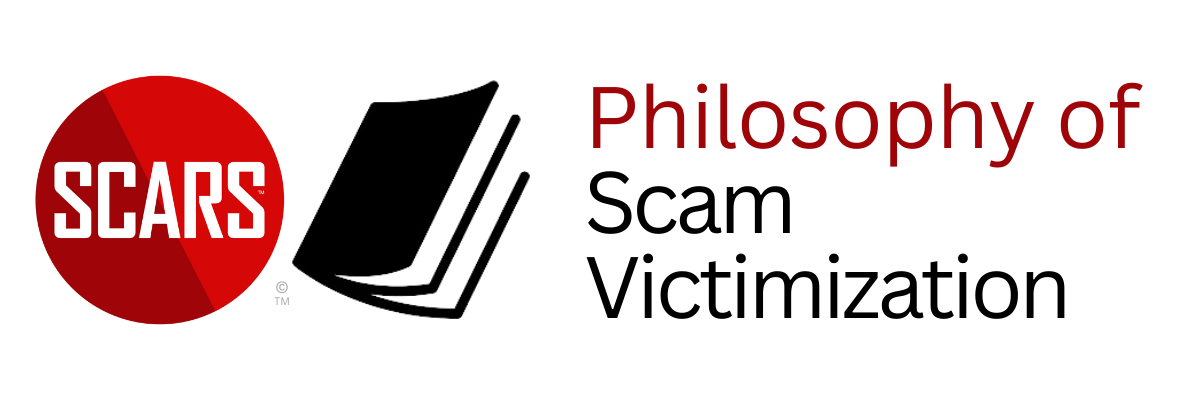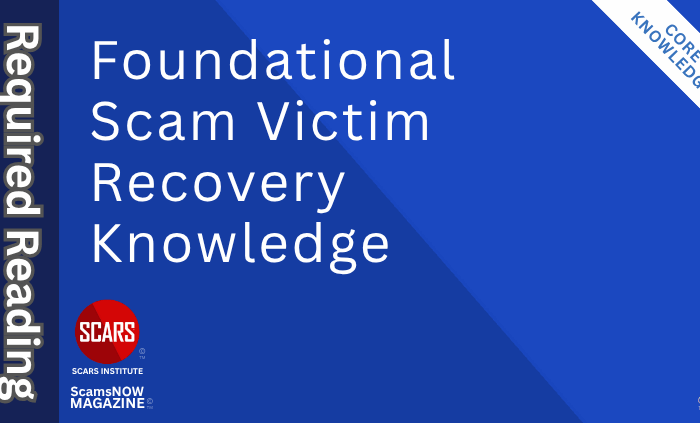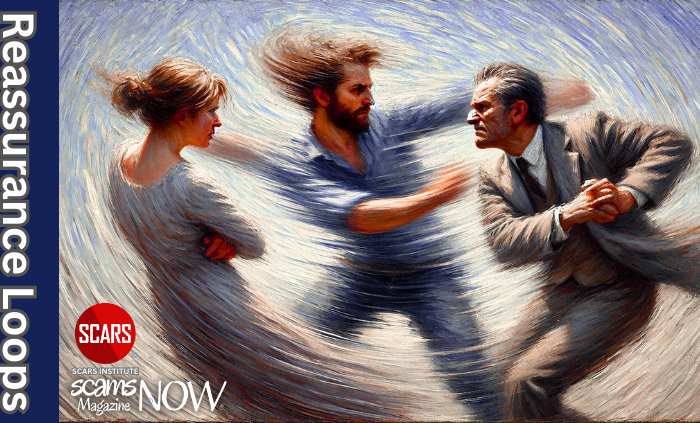
Betrayal & the 9th Circle of Hell
Betrayal, the Ninth Circle of the Inferno, and the Costs of Accepting Fraud
Primary Category: Scam Victim Recovery Philosophy
Author:
• Tim McGuinness, Ph.D., DFin, MCPO, MAnth – Anthropologist, Scientist, Polymath, Director of the Society of Citizens Against Relationship Scams Inc.
Author Biographies Below
About This Article
Betrayal is the deliberate breaking of trust for gain, and it harms bodies, minds, and the shared life that holds communities together. Using Dante’s ninth circle as a moral lens, calculated deception appears as a cold act that freezes human bonds. Modern scammers study hopes, copy care, and turn promises into tools, which leaves trauma, shame, and doubt that can linger. When crime is treated as ordinary, reporting drops, services weaken, and public faith erodes. Clear language that names fraud as intentional harm, steady accountability for organized actors, and respectful support for those injured may restore measure. Education that treats online persuasion as literacy, practical prevention in finance and law enforcement, and community routines that reward honesty can warm the commons. The claim is direct and public. Trust is a shared good, fraud is a grave wrong, and societies grow safer when betrayal is judged plainly and care for the injured remains strong.
Note: This article is intended for informational purposes and does not replace professional medical advice. If you are experiencing distress, please consult a qualified mental health professional.

Betrayal, the Ninth Circle, and the Costs of Accepting Fraud
What is Betrayal?
Betrayal is the deliberate breaking of trust. It occurs when a person gives the appearance of loyalty, care, or honesty, then chooses deception for personal gain. A betrayer studies what another values, learns where confidence lives, and uses that knowledge to harm. The act reaches beyond a single lie. It targets the bond that lets people work together, ask for help, and believe that promises matter.
The impact on human beings is deep because trust is a biological and social anchor. When trust breaks, the body moves into threat chemistry, and the mind searches for safety. Many experience sleep disruption, headaches, chest tension, gut upset, and a racing heart. Intrusive memories, startle reactions, and narrowed attention often follow. These are typical trauma responses. They reflect a nervous system pushed into constant readiness by a serious relational injury.
Betrayal also injures meaning. People ask whether judgments can be trusted, whether kindness is safe, and whether community stands when tested. The story of the self can feel split between what seemed real and what proved false. Shame and grief rise together, since the feelings were real even if the person was not. This mix can slow reporting, delay care, and strain families who are trying to understand what happened.
In fraud, betrayal is planned, repeated, and scaled. Scammers and criminal groups build scripts that mimic affection, authority, or opportunity. They stage proof, isolate targets, and compress time. The goal is control. The method is the exploitation of ordinary human goods, such as hope, duty, and the desire to help. The result is not only a transfer of money. It is a wound to the shared trust that allows society to function.
Naming the act clearly matters. A betrayer is not clever. A victim is not foolish. The harm is a serious violation of trust, carried out with intent, that leaves physical, emotional, and civic consequences. Recognizing betrayal in these terms keeps moral focus where it belongs and creates space for practical responses that support recovery and protect the common good.
Dante’s Inferno and the Moral Map of Hell
Dante Alighieri’s Inferno presents a structured vision of sin and consequence within the larger epic poem series, The Divine Comedy. Guided by Virgil through nine descending circles, the pilgrim encounters punishments that mirror the nature of each offense. This device, called contrapasso, matches penalty to deed, and teaches through image, story, and proportion. The journey is not only a tour of suffering. It is a moral map that ranks harms by how they fracture love, trust, and community. In this context, Betrayal is viewed as the most severe of the sins and is placed right next to Satan because of it.
Lower circles judge intentional injury to others. Fraud or Betrayal appears below violence because it destroys truth, which makes cooperation possible. The final circle, Treachery, holds betrayers frozen in the ice of Cocytus near Satan himself. The cold matters. Heat suggests passion and impulse, while ice suggests calculated harm. Dante’s vision makes betrayal the coldest sin, since it turns knowledge of a bond into a tool for ruin. Within that frozen lake, Dante marks degrees of treachery against kin, country, guests, and benefactors, which shows how social ties grow more sacred as they become more intimate or more generous.
The poem links private ethics to public order. Lies told for gain break more than a promise. They corrode trust, slow cooperation, and weaken shared institutions. By placing fraud and treachery at the bottom, Dante signals that societies fail when truth becomes a weapon and loyalty becomes a mask. The setting also teaches about memory and consequence. Souls in ice cannot move or grow, which reflects the self-imprisonment that follows deliberate deception.
Inferno endures because it translates moral insight into concrete scenes that people can picture. Sinners are not abstractions. They speak, argue, and regret, which turns each encounter into a study of motive, habit, and result. Readers learn that intention matters, pattern matters, and community bears the cost when trust collapses. The poem’s order invites reflection on modern harms that depend on deception, including organized fraud. When truth is sold and bonds are mined for profit, the damage reaches far beyond any single victim. Dante’s vision names that damage, places it in a clear hierarchy, and reminds every age that betrayal sits nearest to the center of ruin because it unravels the very fabric that holds people together.
The Ninth Circle as Mirror
They placed betrayers at the bottom of Dante’s Hell for a reason. In the Inferno, the ninth circle holds those who broke trust at its deepest level, fixed in ice rather than burned by fire, because betrayal freezes the human bond that keeps a community alive. That image still speaks to modern life, where deliberate fraud by scammers, corrupt brokers, and organized crime does more than strip savings; it strikes the shared trust that allows strangers to trade, learn, work, seek care, and rely on one another. As deception spreads through private messages, spoofed calls, and fabricated platforms, the damage radiates outward from one account to a whole culture, and when a society begins to accept crime as ordinary, the ice thickens.
Why Betrayal Cuts Deepest
Dante placed murderers and tyrants in a higher circle than betrayers to kin, city, guests, and benefactors, a moral ranking that claims violence harms bodies while betrayal breaks the trust that makes every other good possible. Modern ethics often aligns with that judgment. Trust quietly supports daily life, enabling contracts to bind, hospitals to function, courts to command consent, and schools to form students who believe in one another. Aristotle wrote about friendship and civic bonds as the glue of the polis, while Kant condemned lies because they treat people as tools rather than ends in themselves. Fraud is a planned lie that uses a victim’s hopes and duties as levers. Social contract theorists described an exchange of fear for safety under shared rules; fraud severs that exchange and leaves suspicion in its place. In the digital age, the moral weight of betrayal has not changed, yet the reach has expanded through instant payments, cloned voices, disposable domains, and constant access to targets. The circle of ice now covers far more ground.
How Fraud Attacks the Human Bond
Deliberate fraud is an organized craft that studies how attention, emotion, and attachment work, then turns that knowledge against its targets. Romance scammers mirror language and habits to form bonds, investment fraudsters stage dashboards to simulate gains, and criminal networks build long grooming arcs that combine praise, urgency, and staged proof to create compliance. Each tactic exploits the same human goods that build families and neighborhoods, which is why fraud not only steals but also desecrates. Secrecy blocks the social immune system, speed outruns reflection, and isolation prevents a saving call to a friend or bank. Victims often emerge with grief, shame, and bodies that learned the scammer’s rhythm, so stress signals continue after contact ends. Communities pay a second price as each new story feeds a slow drift toward cynicism; neighbors begin to say that everyone lies online, children learn that trust carries only risk, merchants add locks and friction, and the public square grows colder.
The Temptation to Accept Crime as Normal
After repeated waves of scams, resignation often arrives. People say that fraud is simply part of life, expect a weak follow-up, and assume funds will never return. Resignation can feel practical, yet it becomes a second betrayal because it hands the field to the worst actors. Acceptance corrodes institutions; specialized police work loses support, financial firms emphasize scripted denials over prevention, and public reporting drops, which hides patterns and slows policy. A loop forms: fewer reports lead to fewer cases, fewer cases reduce faith, and reduced faith suppresses reports. In that cold, families stop talking about scams at the dinner table, elders keep silent after a bad call because they fear blame, and silence becomes the ice in which traitors thrive.
The Moral Depth of Deliberate Fraud
Deliberate betrayal is not a simple error; it is a choice that sees a person as prey, plans the breach of duty, and often recruits others into the plan. Classical thought would name this vice rather than a mistake. The law names it a pattern of crimes. Socially, it functions as a parasite feeding on trust it did not build. Dante’s choice of ice carries a theological claim that betrayal denies love understood as the will to seek another’s good in right order. Treachery toward family, city, guests, and benefactors violates the circles of trust that sustain human life; modern fraud echoes this path by targeting kinship terms, civic identity, the welcome extended to guests online, and the confidence placed in teachers, mentors, and professionals. Clear language helps preserve moral measure. Grooming is not romance, a script is not friendship, and a fake platform is not an investment. Naming the acts accurately protects victims from false shame and keeps the standard visible.
What Betrayal Does to Victims and Bystanders
Victims frequently experience months of physiological stress: sleep disruption, pain, intrusive images, startling to small cues, and narrowed attention. These are ordinary results of coercion and loss, not markers of weakness. Bystanders who respond with jokes or blame deepen the harm, while communities that respond with calm facts, respectful process, and practical support help the ice begin to crack. Repeated exposure to fraud stories can teach helplessness; people scroll, shake heads, and move on, which slowly builds a culture of spectators. A different response treats fraud as a public safety issue, with education that respects victims, reporting that is simple and consistent, and enforcement aimed at organized actors rather than misplaced suspicion toward those who were deceived.
Law, Mercy, and the Order of Trust
Sanctions, seizures, and well-built cases can damage organized rings when used with care and resolve, while restitution and victim services support partial repair. Law and mercy require a moral frame that says betrayal matters because people matter, not only because money moved. Fraud disorders love and duty by seeking gain without truth and cultivating skill without conscience. The right social answer favors firm, humane order: prevention that actually reduces exposure, response that honors consent and pace, and accountability that treats betrayers as responsible agents who chose harm.
The Duty to Warm the Commons
A cold public square grows not only from acts of betrayers but also from the absence of shared work. Warmth returns where neighbors teach one another how scams look, schools treat online persuasion as literacy, banks design alerts and holds that make sense to elders, officers and advocates use steady, plain language, and leaders tell the truth about both harm and hope. Accepting crime as ordinary is a kind of surrender. Refusing to speak about fraud is another. Treating victims as fools is a third. Each surrender thickens the ice, while the opposing habits are modest and powerful: steady attention, careful words, and public routines that reward honesty and penalize deceit.
Judgment Without Cynicism
Some claim that scams are an inevitable cost of modern life, that risk belongs solely to buyers, and that adults should have known better. That view confuses blame with accountability. Adults remain accountable for their choices, and betrayers remain accountable for theirs, yet accountability does not erase the moral difference between error and a calculated plan to exploit trust. When a community blurs this difference, it encourages the worst actors and discourages the best. Dante’s map is not policy, yet it offers moral instruction: broken trust unravels the levels above it, and societies that treat betrayal lightly become cold and poor in spirit. Societies that judge betrayal clearly, care for the harmed, and refuse indifference become warmer, safer, and more human.
Beyond Resignation
Cynicism often feels like protection after too many lies, because it asks for no effort and wears the badge of realism. Yet cynicism serves betrayers by making trust a joke and helping them appear naive. Skepticism offers a better path. It tests claims, seeks evidence, and still believes that truth exists. Public life benefits when skepticism replaces cynicism and honesty replaces cleverness as the admired skill. Trust can grow again in small circles: one helper who honors consent and pace, one team that designs tools that truly help, one newsroom that reports fraud without shaming victims, one city that supports a unit trained in elder abuse and financial crimes. None of this erases evil, yet each step reduces its reach and raises the temperature of the commons.
Conclusion
The ninth circle remains a warning about what happens when treachery becomes the deepest habit. Modern betrayers are not mythical figures; they are people who choose to gain through lies. The rest of society is not powerless; they are neighbors, workers, and leaders who can keep promises, tell the truth, and hold wrongdoers to account. If a culture refuses to accept crime as ordinary, keeps victims within the circle of care, and treats betrayal as a grave wrong rather than a clever game, the ice thins. Trust begins to move again, slow at first, then sure. That movement is not sentiment. It is the practical condition for trade, learning, and care. Dante’s map still reads as moral guidance: betrayal belongs in the deepest cold, while human life belongs in warmer light where honesty, patience, and courage can stand together, and where the bonds that hold a society do not snap when tested, but hold fast.

Glossary
- Acceptance of Crime as Normal — After repeated scams, resignation may feel practical. The habit teaches that crime is ordinary, which hands space to criminals and thins reporting, support, and public will.
- Accountability — In clear terms, a betrayer chose harm, and you did not consent to that choice. Holding offenders responsible, while treating victims with respect, restores moral order and supports recovery.
- Aristotle’s Civic Friendship — Ancient writers described friendship and shared duty as the glue of a city. When fraud spreads, you see that glue weaken, because trust and mutual goodwill are targets.
- Authorities and Institutions — Police, banks, and agencies vary in training and resources. Judging each contact on present behavior, with concise facts in hand, may open doors that earlier contacts closed.
- Benefactor — A benefactor gives help or opportunity without obligation. Betraying a benefactor strikes a deeper bond, which is why Dante places that breach near the center of ruin.
- Betrayal — Betrayal is the deliberate breaking of trust for gain. The act wounds body, mind, and meaning, because it targets the bond that makes promises, cooperation, and safety possible.
- Betrayer — A betrayer studies your values and confidence, then uses that knowledge to harm. The pattern is not cleverness; it is a planned violation that leaves personal and civic damage.
- Bystander Response — Jokes, blame, or silence deepen harm. Calm facts, respectful process, and practical steps help you feel seen, which lowers shame and supports action.
- Civic Trust — Civic trust lets strangers trade, learn, seek care, and rely on shared rules. Fraud erodes this trust, so daily life grows colder, slower, and more suspicious.
- Cocytus (Ice Lake) — In Dante’s final circle, betrayers freeze in ice, not fire. The image teaches that calculated deceit chills human bonds and locks growth in place.
- Coercion — Coercion uses pressure, isolation, and speed to bend your choices. Afterward, your body may still respond to those cues, which makes support and structure important.
- Contrapasso — Dante matches penalty to deed so readers grasp moral weight. By placing treachery in ice, the poem marks betrayal as the coldest harm to the human bond.
- Crime Normalization Loop — When reporting drops, cases fall, faith weakens, and reporting drops again. Breaking the loop needs steady education, simple reporting paths, and visible follow-through.
- Deception Scripts — Scripts mimic affection, authority, or opportunity using staged proof and urgency. Recognizing the patterns helps you name harm clearly and step back sooner.
- Dante’s Inferno — The poem maps harms in nine circles, ranking deceit below violence. Its order teaches that destroying truth breaks the ground where community stands.
- Enforcement Focus — Well-built cases against organized actors, with seizures and sanctions, reduce reach. Clear priorities spare victims from misplaced suspicion and aim pressure where it belongs.
- Evidence and Verification — Short notes with dates, amounts, names, and links help you present facts. Verification slows quick leaps and protects you from new pressure.
- Fraud — Fraud is a planned lie for gain that exploits hope, duty, and the desire to help. The loss is money and trust, which is why recovery needs both care and order.
- Grooming — Grooming builds false intimacy through mirroring, praise, and shared routines. The aim is control, not connection, and the result is grief and confusion when the mask drops.
- Grief and Shame — Grief follows because feelings were real, even if the person was not. Shame eases when language stays accurate and kind, which supports reporting and care.
- Helplessness, Learned — Repeated exposure to fraud stories can teach that nothing works. Small, successful steps—clear asks, short reports, and one helpful contact—begin to reverse that lesson.
- Ice Metaphor — Cold stands for calculation and the death of movement. When trust freezes, you feel stuck; warm, steady routines help thaw the day.
- Isolation — Secrecy and embarrassment isolate victims. Safe company and measured disclosure reduce silence, which often lowers distress and improves choices.
- Judgment Without Cynicism — Clear judgment names betrayal as grave harm without mocking victims. This stance supports accountability and keeps hope honest rather than naive.
- Kant’s View of Lying — Lying treats people as tools rather than ends. Fraud fits that pattern, which is why moral language matters when you tell your story.
- Law and Mercy — Firm law restrains organized harm, and humane support steadies victims. Together, they say people matter more than money moved.
- Meaning-Making — Betrayal splits what seemed real from what proved false. Plain words, simple rituals, and respectful help allow you to rebuild a story that fits the facts.
- Moral Injury — Betrayal injures values as well as feelings. Naming the breach and seeking fair process help restore dignity and self-respect.
- Ninth Circle (Treachery) — The final circle holds betrayers of kin, country, guests, and benefactors. The ranking signals that breaking trust unravels every other good.
- Normalization Resistance — Refusing to accept crime as ordinary keeps standards visible. Teaching, reporting, and design changes in finance and tech raise the temperature of the commons.
- Organized Crime — Networks script roles, launder funds, and scale harm. Disrupting supply chains and money flows matters, because single arrests rarely change the system.
- Public Square (The Commons) — The commons grows warmer where honesty is rewarded and deceit is penalized. Schools, banks, media, and agencies share that work.
- Reporting — Timely, simple reports reveal patterns and support action. Even partial information helps, and a calm pace can make the task doable.
- Resignation — Resignation feels like realism after too many lies. In practice, it surrenders ground to offenders and chills the will to act.
- Restitution — Restitution cannot erase harm, yet it recognizes loss and supports rebuilding. Fair process around repayment also signals that trust still has guardians.
- Secrecy and Speed — Secrecy blocks help, and speed outruns reflection. Slowing contact and widening the circle to include one safe person can change outcomes.
- Shame — Shame often says keep quiet. Accurate language and steady allies lower shame, which opens doors to care and accountability.
- Skepticism — Skepticism tests claims and seeks evidence while keeping faith that truth exists. This stance protects you better than cynicism, which mocks trust and helps offenders.
- Social Contract — Shared rules trade fear for safety and allow cooperation. Fraud breaks that trade, which is why public response is more than private loss.
- Stress Responses — Sleep disruption, pain, startle, and narrowed attention often follow betrayal. These symptoms are common and may ease with structure, care, and time.
- Treachery — Treachery is betrayal against a specific bond, such as family or benefactor. The closer the bond, the deeper the wound and the wider the social cost.
- Trauma Responses — Intrusive images, hypervigilance, and dissociation can appear after coercion and loss. Gentle routines and informed care help the nervous system settle.
- Trust — Trust allows risk for shared benefit. Clear boundaries, verification, and accountable systems help trust grow again without swinging to suspicion or haste.
- Urgency Cues — Timers, crises, and deadlines press you to act fast. Pausing, verifying, and phoning a known number reduce pressure and error.
- Victim Blaming — Blame hides the offender’s choice and increases isolation. Respectful language and public education keep focus where it belongs.
- Virgil (Guide) — In the poem, Virgil guides the pilgrim through hard truth. In practice, a calm helper—therapist, advocate, or trained officer—can steady your steps through complex systems.
- Warm the Commons — Communities warm when neighbors teach fraud signs, banks add sensible holds, and leaders tell the truth about harm and hope. Small, repeated acts raise public trust.
- Withdrawal-Like Symptoms — Restlessness, urges to check, and waves of sadness may follow the break. The body learned a rhythm; short walks, longer exhales, and safe company help that rhythm change.
Author Biographies
-/ 30 /-
What do you think about this?
Please share your thoughts in a comment below!
TABLE OF CONTENTS
- Betrayal, the Ninth Circle of the Inferno, and the Costs of Accepting Fraud
- Betrayal, the Ninth Circle, and the Costs of Accepting Fraud
- What is Betrayal?
- Dante’s Inferno and the Moral Map of Hell
- The Ninth Circle as Mirror
- Why Betrayal Cuts Deepest
- How Fraud Attacks the Human Bond
- The Temptation to Accept Crime as Normal
- The Moral Depth of Deliberate Fraud
- What Betrayal Does to Victims and Bystanders
- Law, Mercy, and the Order of Trust
- The Duty to Warm the Commons
- Judgment Without Cynicism
- Beyond Resignation
- Conclusion
- Glossary
CATEGORIES
![NavyLogo@4x-81[1] Betrayal & the 9th Circle of Hell - 2025](https://scamsnow.com/wp-content/uploads/2025/04/NavyLogo@4x-811.png)
ARTICLE META
Important Information for New Scam Victims
- Please visit www.ScamVictimsSupport.org – a SCARS Website for New Scam Victims & Sextortion Victims.
- SCARS Institute now offers its free, safe, and private Scam Survivor’s Support Community at www.SCARScommunity.org – this is not on a social media platform, it is our own safe & secure platform created by the SCARS Institute especially for scam victims & survivors.
- SCARS Institute now offers a free recovery learning program at www.SCARSeducation.org.
- Please visit www.ScamPsychology.org – to more fully understand the psychological concepts involved in scams and scam victim recovery.
If you are looking for local trauma counselors, please visit counseling.AgainstScams.org
If you need to speak with someone now, you can dial 988 or find phone numbers for crisis hotlines all around the world here: www.opencounseling.com/suicide-hotlines
Statement About Victim Blaming
Some of our articles discuss various aspects of victims. This is both about better understanding victims (the science of victimology) and their behaviors and psychology. This helps us to educate victims/survivors about why these crimes happened and not to blame themselves, better develop recovery programs, and help victims avoid scams in the future. At times, this may sound like blaming the victim, but it does not blame scam victims; we are simply explaining the hows and whys of the experience victims have.
These articles, about the Psychology of Scams or Victim Psychology – meaning that all humans have psychological or cognitive characteristics in common that can either be exploited or work against us – help us all to understand the unique challenges victims face before, during, and after scams, fraud, or cybercrimes. These sometimes talk about some of the vulnerabilities the scammers exploit. Victims rarely have control of them or are even aware of them, until something like a scam happens, and then they can learn how their mind works and how to overcome these mechanisms.
Articles like these help victims and others understand these processes and how to help prevent them from being exploited again or to help them recover more easily by understanding their post-scam behaviors. Learn more about the Psychology of Scams at www.ScamPsychology.org
SCARS INSTITUTE RESOURCES:
If You Have Been Victimized By A Scam Or Cybercrime
♦ If you are a victim of scams, go to www.ScamVictimsSupport.org for real knowledge and help
♦ SCARS Institute now offers its free, safe, and private Scam Survivor’s Support Community at www.SCARScommunity.org/register – this is not on a social media platform, it is our own safe & secure platform created by the SCARS Institute especially for scam victims & survivors.
♦ Enroll in SCARS Scam Survivor’s School now at www.SCARSeducation.org
♦ To report criminals, visit https://reporting.AgainstScams.org – we will NEVER give your data to money recovery companies like some do!
♦ Follow us and find our podcasts, webinars, and helpful videos on YouTube: https://www.youtube.com/@RomancescamsNowcom
♦ Learn about the Psychology of Scams at www.ScamPsychology.org
♦ Dig deeper into the reality of scams, fraud, and cybercrime at www.ScamsNOW.com and www.RomanceScamsNOW.com
♦ Scam Survivor’s Stories: www.ScamSurvivorStories.org
♦ For Scam Victim Advocates visit www.ScamVictimsAdvocates.org
♦ See more scammer photos on www.ScammerPhotos.com
You can also find the SCARS Institute’s knowledge and information on Facebook, Instagram, X, LinkedIn, and TruthSocial
Psychology Disclaimer:
All articles about psychology and the human brain on this website are for information & education only
The information provided in this and other SCARS articles are intended for educational and self-help purposes only and should not be construed as a substitute for professional therapy or counseling.
Note about Mindfulness: Mindfulness practices have the potential to create psychological distress for some individuals. Please consult a mental health professional or experienced meditation instructor for guidance should you encounter difficulties.
While any self-help techniques outlined herein may be beneficial for scam victims seeking to recover from their experience and move towards recovery, it is important to consult with a qualified mental health professional before initiating any course of action. Each individual’s experience and needs are unique, and what works for one person may not be suitable for another.
Additionally, any approach may not be appropriate for individuals with certain pre-existing mental health conditions or trauma histories. It is advisable to seek guidance from a licensed therapist or counselor who can provide personalized support, guidance, and treatment tailored to your specific needs.
If you are experiencing significant distress or emotional difficulties related to a scam or other traumatic event, please consult your doctor or mental health provider for appropriate care and support.
Also read our SCARS Institute Statement about Professional Care for Scam Victims – click here
If you are in crisis, feeling desperate, or in despair, please call 988 or your local crisis hotline – international numbers here.
More ScamsNOW.com Articles
A Question of Trust
At the SCARS Institute, we invite you to do your own research on the topics we speak about and publish. Our team investigates the subject being discussed, especially when it comes to understanding the scam victims-survivors’ experience. You can do Google searches, but in many cases, you will have to wade through scientific papers and studies. However, remember that biases and perspectives matter and influence the outcome. Regardless, we encourage you to explore these topics as thoroughly as you can for your own awareness.
























![scars-institute[1] Betrayal & the 9th Circle of Hell - 2025](https://scamsnow.com/wp-content/uploads/2025/04/scars-institute1.png)

![niprc1.png1_-150×1501-1[1] Betrayal & the 9th Circle of Hell - 2025](https://scamsnow.com/wp-content/uploads/2025/04/niprc1.png1_-150x1501-11.webp)
